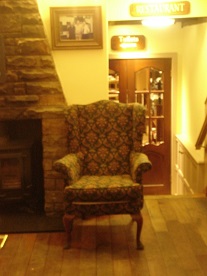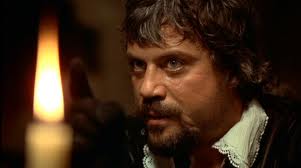
I’ve not had time to write much on this blog recently because of my current work commitments. Unfortunately, in this era of Covid-19-imposed confinement, none of this work involves me moving away from the laptop on the desk in a corner of my bedroom. Moreover, because I’ve had quite a few short stories published recently under the pseudonyms of Jim Mountfield and Rab Foster, I’m also trying to keep momentum going with those and am devoting additional time to writing, revising and submitting short fiction.
In the meantime, in the absence of new blog entries, here’s a reposting of something I wrote for this blog in 2014. It seemed to get an enthusiastic response at the time and, indeed, I think someone made the entry into a poster that was put on the wall of – where else? – the Pub in Valetta. Alas, since this was written, Peter Cassidy, the then-owner of the Crown Hotel, has passed away. Meanwhile, I assume that the chair is still there.
Certain towns and cities around the world can boast of having ancient and holy relics. In the Christian world, for example, Sienna has the mummified head of Saint Catherine in its Basilica Cateriniana San Domenico. Paris has what is alleged to be the crown of thorns worn by Christ at his crucifixion in its Notre Dame Cathedral. And in Rome’s Basilica di Santa Croce, you can see part of the index finger of Saint Thomas, the finger that as a sceptical disciple he poked into the wound in the side of the resurrected Christ to check if it was real. Some places have relics so special that they are said to have healing or protective powers. Naples, for instance, is lucky enough to have in its city cathedral the dried blood of St Januarius, which protects it from disasters like earthquakes and plagues.
However, my hometown of Peebles in the south of Scotland contains surely the most powerful holy relic of all. Because in the public bar of the Crown Hotel on Peebles High Street you’ll find the armchair of Oliver Reed.
This hallowed item of furniture, on which the legendary hell-raising star of movies such as Hannibal Brooks (1969), Women in Love (1969), The Devils (1971), The Three and Four Musketeers (1973-74) and Tommy (1975) once rested his butt, is rumoured to have healing powers too. A pilgrim who reposes against its upholstery will, with time, be cured of certain pernicious ailments. He or she will be cured of sobriety, for instance. And common sense. And dignity.
The story behind the chair is that, in the middle of the 1990s, Oliver Reed found himself staying in Peebles whilst doing some location filming for a Scottish movie called The Bruce (1996), a quick, cheap cash-in on Mel Gibson’s Braveheart (1995), which had recently been cleaning up at the box office. I’ve never seen The Bruce, but from all accounts it’s terrible. Reed being Reed, of course, he soon managed to sniff out the pub in town containing the biggest number of what are euphemistically known as ‘local characters’, which was the Crown’s public bar. He then set up camp there for several days, much to the joy of the Scottish tabloid press.
At one point, the Scottish edition of the Sun published on its front page a photo of an inebriated Reed passed out against the inside of the Crown’s entrance door, while someone outside tried to push his way in. No doubt he was thinking, “What the hell’s blocking the door…? Oh… It’s Oliver Reed.” For some reason Reed was clutching a toy sheep at the time so the Sun’s headline was, inevitably, SHAME ON EWE.
During his sojourn in the Crown, Reed complained to the hotel owner Peter Cassidy about the hardness of his seats and then thrust a bundle of notes into the hand of a regular called Davie Lees and ordered him to go to the local furniture store, the Castle Warehouse, and buy the pub a properly upholstered, properly comfortable armchair. Davie obliged, and the armchair now resides against a back wall of the public bar, under a framed photo of a well-refreshed Reed posing with Cassidy outside the hotel.
Reed departed for the great pub in the sky back in 1999, when he expired during the filming of Ridley Scott’s Gladiator (1999) in Malta. He keeled over and breathed his last in, appropriately enough, a Valetta bar called the Pub, after he’d taken on a squad of British sailors in a series of drinking and arm-wrestling contests. However, I have a feeling that the great man’s psychic residue lives on in that armchair in the Crown.
Just a few days ago, I’d arranged to meet my Dad for a meal in the Crown’s restaurant. As the Oliver Reed armchair is aligned with the pub’s front door, I sat down in it so that I could watch the door and spot my Dad as soon as he walked in.
Immediately after sitting down, I found myself possessed by strange urges – to drink 104 pints in one sitting and then climb up the nearest chimneystack naked whilst roaring, “I’m Santa Claus!”; to indulge in a nude fireside wrestling match with Alan Bates; to vomit over Steve McQueen; to smuggle an elephant over the Alps; to take the local rugby club on a drinking spree and then organise a naked cross-country run with them through the surrounding moonlit fields; to film a Musketeers movie and stab several stunt-swordsmen during the fight scenes; to insult Jack Nicholson about his height, Richard Harris about his toupee and Raquel Welch about the thickness of her ankles; to arrive drunk at Galway Airport lying on the baggage conveyor; to chase ace snooker player Alex ‘Hurricane’ Higgins around a house with an axe; and to get a bird-claw tattoo done on my willie, which I’d subsequently threaten to whip out and display to the cameras every time I did a TV chat-show interview.
But then my Dad came into the hotel, I rose from the seat and the strange spell was broken. So instead I ordered a half-pint of lager shandy and a plate of supreme-of-chicken with honey-and-mustard sauce, and later washed everything down with a nice cup of coffee. And then went home to my bed.

© 20th Century Fox
